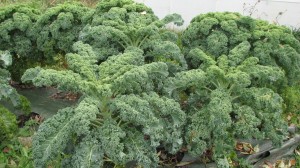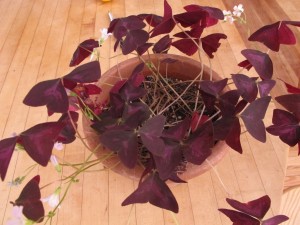The Irish Gardener
My great-grandmother took the boat from Ireland to Boston in the latter part of the 1800’s. Dobbie, as we called her, got a job as a cook at Wellesley College. That was a bit ironic because she was, in my memory, a wonderful person but a horrible cook. She never made me anything that I can recall eating with pleasure. Even her boiled eggs – usually a favorite of mine- were runny and disgusting.
So, despite the fact that I am one quarter Irish, for a long time I never paid much attention to Irish food. Not so any more. With St Paddy’s day just around the corner, I will soon be cooking up a big pot of colcannon, one of the great comfort foods of all time. It’s a wonderful combination of potatoes and kale – foods that I still have from last summer’s garden.
As a gardener and a chef I appreciate the value of potatoes, especially potatoes from my own garden. Potatoes come in as many colors and flavors as tomatoes. I grow potatoes with flesh that is white, yellow, pink and purple. I store and save potatoes, and once I went about 20 years without buying a potato to eat or plant. I just started this year’s planting with last year’s potatoes and I stopped eating potatoes when I ran out – until the next crop came in.
But back to colcannon. It is a potato dish I always eat on St. Patrick’s Day. It is easy to make and tasty to eat. I generally use a white potato such as the Kennebec, which is also my most productive variety. One chunk of potato planted can yield up to 5 pounds of potatoes.! They grow big and are great for mashing. The other main vegetable in colcannon is kale, which I grow in quantity and freeze for winter use. I like a variety called Winterbor which is readily available by seed or as seedlings at your local garden center. Here’s how to make a nice Irish side dish:
Ingredients:
2-3lbs of white potatoes
5-6 Tablespoons butter
3 cups kale, fresh or frozen, chopped finely & lightly packed in a measuring cup
½ cup onion finely chopped, or 3 green onions (including the greens)
1 cup whole milk or light cream
Method:
- Peel and boil the potatoes until they will fall apart when poked with a fork.
Drain. - Sauté onions and kale in the butter in a heavy pot on medium heat for 3 to 5 minutes.
- Add potatoes, stir.
- Add the milk (or cream for sheer decadence) and mash well using an old fashioned potato masher, not an electric mixer.
- Add salt and pepper as desired.
But on with the Irish theme. The rest of the meal should be Guinness stew, but that’s not from my garden, so you’re on your own for that. But as a centerpiece on St Patrick’s Day there should be a plant that screams “Irish”. The shamrock? The true Irish shamrock is a type of clover (Trifolium dubium) that is very hard to grow indoors and is rarely available even from florists and nurseries. What you can grow as a house plant is a type of wood sorrel commonly called oxalis. It looks like the Hallmark version of a shamrock.
Oxalis is a nice house plant that comes in green and maroon-leafed varieties – though for St Patrick’s Day green is the proper selection. There are some 300 species of oxalis. Mine do well in a bright window – I have 2 of the maroon-leafed ones in bloom right now. In the summer they thrive on my somewhat shady deck. The light pink flowers are small and reach up above the leaves on thin stems. The leaves fold up at night time.
One of the great things about oxalis is that it is nearly impossible to kill by under-watering it. The leaves may shrivel up and die off, but if this happens, just give it a rest –which I have read it likes – and it will bounce back when you start watering it a few weeks later.
If you have an oxalis, you can divide it easily by separating the corms (the thickened roots) and planting pieces of them in new pots with fresh planting medium. Like most houseplants, oxalis does not do well if the roots stay constantly wet. I have planted mine in potting soil enriched with compost. I find a 50-50 mix is good. I have learned to judge dryness of the soil by lifting the pot. The surface may look dry, but if the pot is heavy there is still plenty of moisture down below.
Whether you have some Irish in you or not, grow potatoes and kale this year. Both are supremely easy. But it’s too cold to think about that now – except as ingredients in colcannon. Bon appétit!
Henry Homeyer is the author of 4 gardening books and a children’s fantasy-adventure about a boy and a cougar. His Web site is www.Gardening-guy.com.




